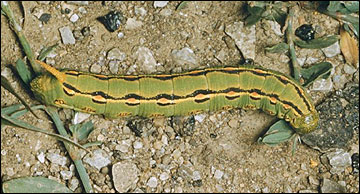Whitelined sphinx
Hornworms
 Whitelined sphinx caterpillars (Hyles lineata) are present from spring to early fall. They produce one to two generations per year.
Whitelined sphinx caterpillars (Hyles lineata) are present from spring to early fall. They produce one to two generations per year.
Whitelined sphinx is perhaps one of the most widely distributed sphingids in North America. Full-grown caterpillars are about 3 inches long with a green body. On the top of most body segments (about a head's width apart) is a pair of pale brown spots that are connected lengthwise down the body within a yellow line. The area above and below each brown spot is outlined in black. The spiracles on each side of the body are found within a yellow area outlined in black. Caterpillars feed on a wide range of host plants, a favorite being purslane, but they often prefer weeds. If weeds are not available, they will feed on such vegetables as tomato, lettuce, turnip, beet, watermelon and cantaloupe. Known fruit hosts include apple, pear, grape, currant and gooseberry.
About the family
Many caterpillar species in the Sphingidae family are referred to as hornworms because they have a conspicuous horn or spine on the top of the last abdominal segment. The bodies of these caterpillars are usually free of hairlike setae and smooth except for shallow wrinkles in each segment. Adults are referred to as sphinx, hawk or hummingbird moths. They are fast, strong fliers with a rapid wing beat and often hover in front of a flower to feed on the nectar in much the same manner as a hummingbird (and superficially they look like a hummingbird too!). The name sphinx is probably in reference to the sphinx-like position that some of the caterpillars assume when disturbed. Some common vegetable, tobacco and other plant pests belong to this family of caterpillars.